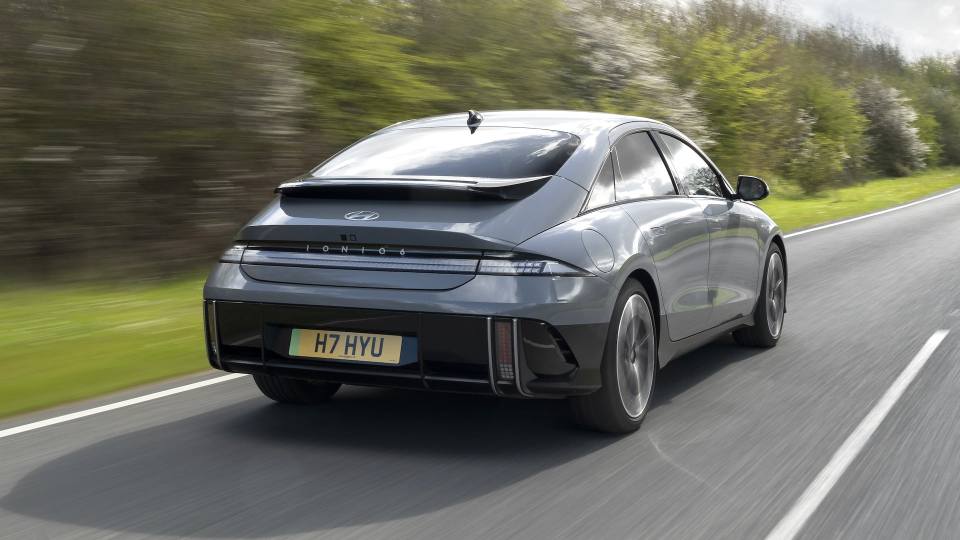Hyundai Ioniq 6 review: sleek electric saloon is a smooth operator

Following the success of its radical Ioniq 5 electric SUV, this could have been Hyundai’s difficult follow-up album, as the Korean brand wonders what to do next. However, while it shares the same platform, the new Ioniq 6 is an upmarket saloon. This sees it pitched against rivals such as the BMW i4, Polestar 2 and omnipresent Tesla Model 3.
Hyundai describes its new EV as an ‘electrified streamliner’, with inspiration coming in part from the aerodynamic car designs of the 1930s. We spot a hint of classic Porsche 911 Turbo in the rear spoilers, too. No bad thing.
It certainly makes the Ioniq 6 hard to ignore on the road, where it generates plenty of attention. The car’s curvaceous looks are about more than just aesthetics, though; they also smooth the airflow to help extend battery range. On the downside, a low roofline eats into headroom, even for drivers of average height. It also makes for a narrow boot opening, so the 401-litre space is awkward to access.
Lights and magic

On the inside, Hyundai has carried over the dual 12.3-inch display setup found in the Ioniq 5, but this time you’ll find a large centre console dividing the front seats, with a useful storage area underneath. Funky ambient lighting – there are even LED lights on the steering wheel – provides a premium feel. The number of options on the infotainment screens can be overwhelming at first, requiring use of a search function to find things.
A host of cameras and sensors give the Ioniq 6 ‘Level 2’ autonomous driving capability, allowing it to follow lanes on a motorway and maintain a set distance behind other cars.
Optional digital side mirrors add £995 to the price of the Ioniq 6. They make for an interesting talking point, but the effectiveness of the camera-based system is debatable. We’d stick with old-fashioned reflective glass.
Going the distance

At present, Hyundai only offers the Ioniq 6 with a 77.4kWh battery pack. This can be combined with a 228hp rear-wheel-drive setup, or there is a 325hp dual-motor, all-wheel-drive model – as tested here. This latter version can accelerate from 0-62mph in 5.1 seconds and reach a top speed of 115mph. With Sport mode engaged, the Ioniq 6 delivers an almost unrelenting surge of power, tempered by regenerative braking that can adjust its effect automatically.
Yet despite such performance, and its head-turning looks, the Ioniq 6 is not a sporty car. It handles competently, but without much feedback, and ride quality is notably firm on its standard 20-inch alloy wheels.
Official tests say it can cover up to 322 miles on a full charge in AWD form. Expect this to be closer to 250 miles if you make use of the air-con or standard heated seats and steering wheel, though. Choosing the rear-driven version increases the quoted range to 338 miles.
The ability to charge at 800 volts also makes the Ioniq 6 a viable long-range EV. Connect it to the fastest charging devices and the battery can be topped up from 10-80 percent in just 18 minutes.
World Car of the Year

A starting price of more than £47,000 for the Ioniq 6 increases to over £54,000 for the AWD Ultimate model we sampled. That’s pricier than a Tesla Model 3, but the Hyundai certainly makes a bigger style statement than the familiar Musk-mobile.
Hyundai has already collected a plethora of awards for the Ioniq 6, including 2023 World Car of the Year, but this swoopy electric saloon is not without its compromises. Its sleek styling limits practicality, for a start, and only results in around 10 percent more range than an Ioniq 5. The plethora of on-board tech feels slightly overwhelming, too.
Nonetheless, the Hyundai Ioniq 6 is a comfortable and very capable electric car for covering long distances. And you’ll never get bored of how it looks.
John Redfern writes for Motoring Research
PRICE: From £50,540
POWER: 325hp
0-62MPH: 5.1sec
TOP SPEED: 115mph
BATTERY SIZE: 77.4kWh
ELECTRIC RANGE: 322 miles